Author: Brian Hall
The hazy juice bombs known as New England IPA have become a world-wide phenomenon, known for its huge hop flavor, restrained bitterness, and pillowy mouthfeel. However, there are some who abhor the cloudy appearance, contending it’s due to poor brewing techniques and rushed time-frames. While many brewers of NEIPA consider the haze a byproduct of the unique brewing process, others rely on methods specifically intended to produce the most nebulous beer possible. Regardless, what is clear is that people drink with their eyes, developing impressions even before taking their first sip.
With rare exception, brewers have historically been hung-up on producing the clearest beer possible, relying on a bright appearance as an indication of quality. Numerous methods have been developed to achieve this desired appearance, from fining in the kettle and long aging to adding certain chemicals that assist in the clarifying process, most of which are left out of the NEIPA brewing process.
Back in June of 2016, we collaborated with Ed Coffey from the Ales Of The Riverwards blog on an xBmt looking into the impact of fining a NEIPA with gelatin. The gelatin fined beer was slightly clearer than the non-fined beer, but it was nowhere near bright, which some speculated was why tasters couldn’t tell them apart. Despite my indifference to a moderate haze, I’ve used some finings for NEIPA, mostly with the goal of reducing hop astringency, and it hasn’t seemed to have a huge impact on appearance.
Curious whether or not the NEIPA haze is a major contributor to its character, I combined several fining methods in hopes of producing a version as bright as its West Coast counterpart, then served them to blind participants to see if they could tell a difference!
| PURPOSE |
To examine the differences between a NEIPA fined with multiple agents and one made with no fining agents.
| METHODS |
I settled on one of my standard NEIPA recipes for this xBmt, relying on all the methods I’ve used in the past to produce a characteristically hazy beer.
Translucence
Recipe Details
| Batch Size | Boil Time | IBU | SRM | Est. OG | Est. FG | ABV |
|---|---|---|---|---|---|---|
| 5.5 gal | 60 min | 53.9 IBUs | 5.4 SRM | 1.053 | 1.012 | 5.4 % |
| Actuals | 1.053 | 1.005 | 6.3 % | |||
Fermentables
| Name | Amount | % |
|---|---|---|
| Pale Malt (2 Row) Bel | 10 lbs | 80 |
| Raw Wheat | 2.5 lbs | 20 |
Hops
| Name | Amount | Time | Use | Form | Alpha % |
|---|---|---|---|---|---|
| Warrior | 9 g | 30 min | Boil | Pellet | 14.3 |
| Citra | 28 g | 5 min | Boil | Pellet | 12 |
| El Dorado | 28 g | 5 min | Boil | Pellet | 14.5 |
| Galaxy | 28 g | 5 min | Boil | Pellet | 15.9 |
| Citra Cryo | 57 g | 1 min | Boil | Pellet | 24 |
| El Dorado | 43 g | 1 min | Boil | Pellet | 14.5 |
| Galaxy | 43 g | 1 min | Boil | Pellet | 15.9 |
| El Dorado | 43 g | 7 days | Dry Hop | Pellet | 15 |
| Citra | 28 g | 7 days | Dry Hop | Pellet | 12 |
| Citra Cryo | 14 g | 7 days | Dry Hop | Pellet | 24 |
| El Dorado | 43 g | 3 days | Dry Hop | Pellet | 15 |
| Citra | 28 g | 3 days | Dry Hop | Pellet | 12 |
| Citra Cryo | 14 g | 3 days | Dry Hop | Pellet | 24 |
Notes
| Water Profile: Ca 126 | Mg 0 | Na 0 | SO4 118 | Cl 135 |
Download
| Download this recipe's BeerXML file |
A few days ahead of time, I collected all of the RO water I would need for this xBmt.
On brew day, I combined the filtered water for both batches in a single kettle, adjusted it to my desired mineral profile, and began heating it with my heat stick.
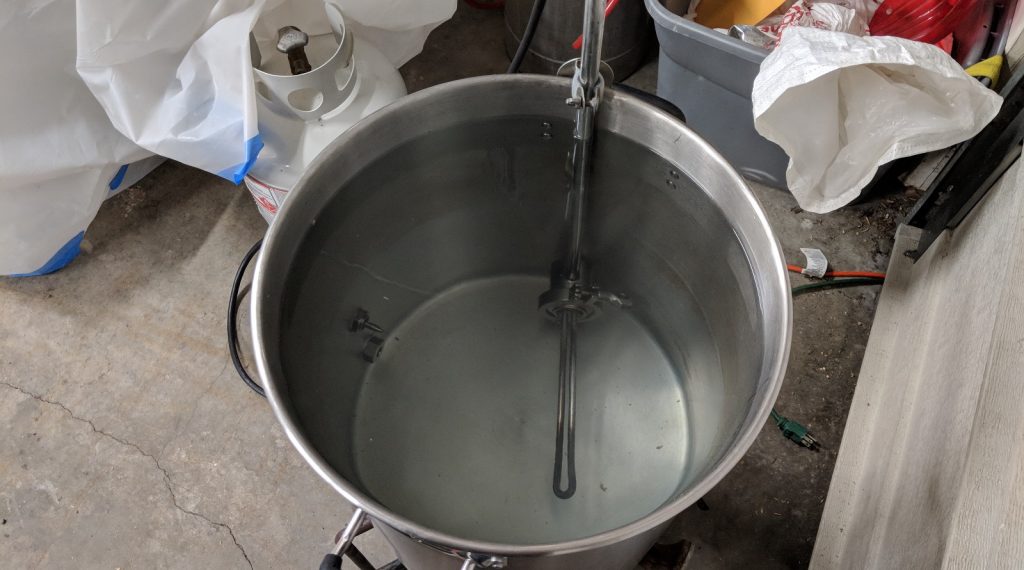
I weighed out and milled the grains for each batch while waiting for the water to heat.
When the water was slightly warmer than strike temperature, I transferred exactly half to a second kettle. I mashed in on the first batch then waited 10 minutes before mashing in on the second batch, checking to ensure both hit the same target mash temperature.
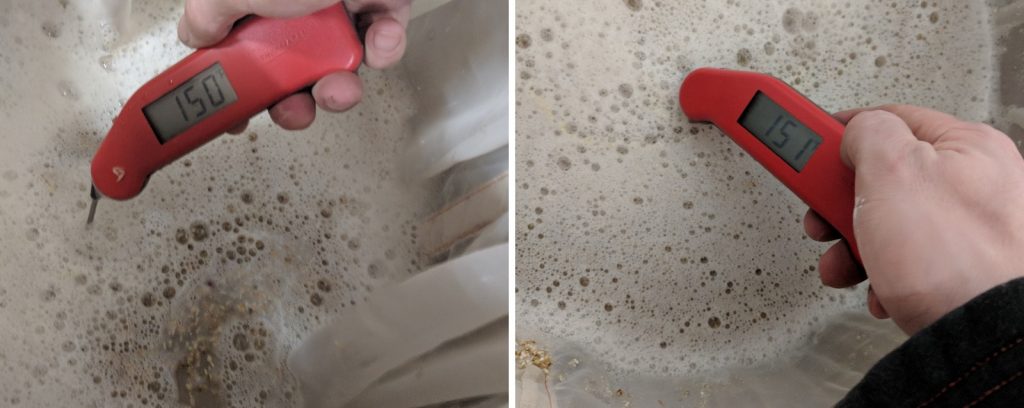
Following 60 minute rests, I removed the grain bags and let the wort drain until the same pre-boil volume was reached.
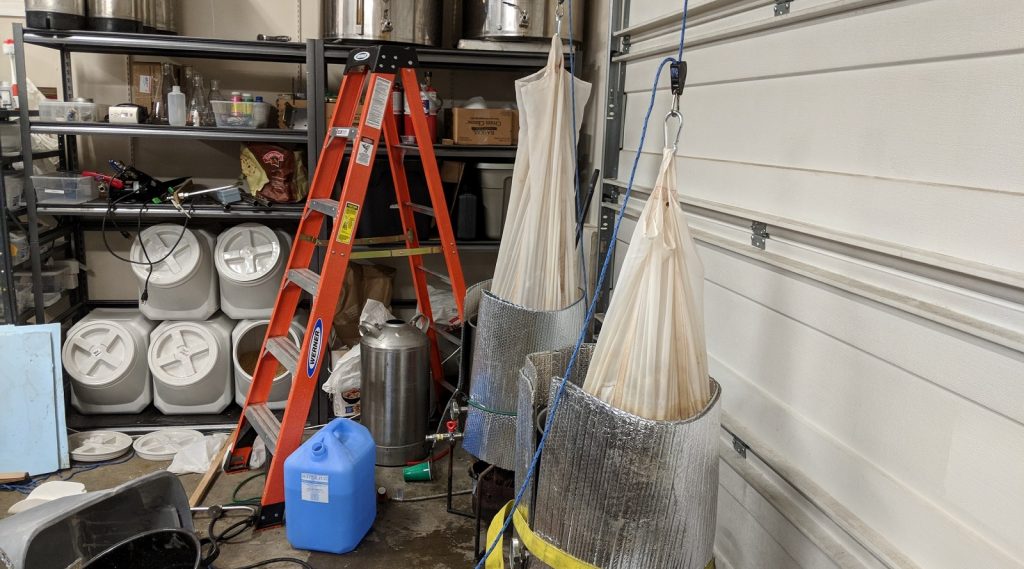
As the worts began heating up, I added the first wort hop additions.
The worts were boiled for 30 minutes with hops added at the same times. With 10 minutes left, I added a tablet of Whirlfloc to the fined wort while the non-fined wort was left alone.
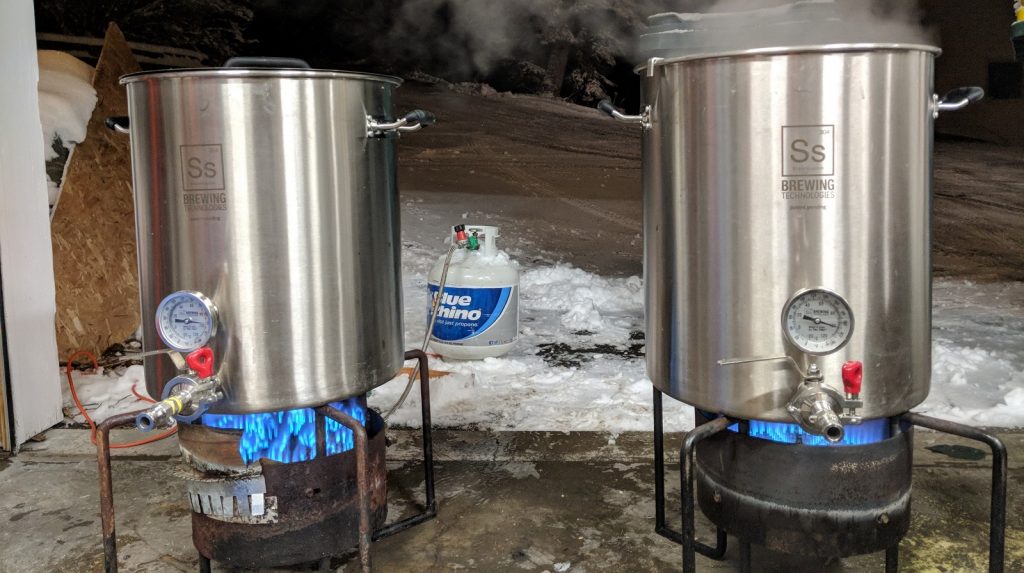
Once each boil was complete, I quickly chilled the worts to my target fermentation temperature of 66°F/19°C. Samples taken at this point showed a noticeable difference in appearance.
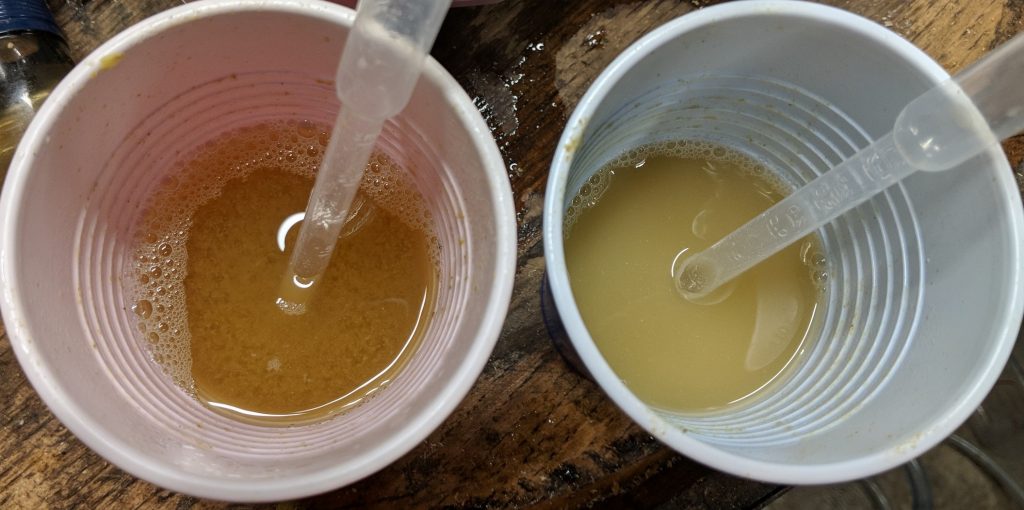
Refractometer readings showed the OG of the fined batch was ever so slightly lower than the non-fined batch.

I racked identical amounts of wort to sanitized glass carboys then pitched a can of Imperial Yeast A38 Juice directly into each.
In the time it took me to clean up, a difference in clarity between the beers became very obvious.
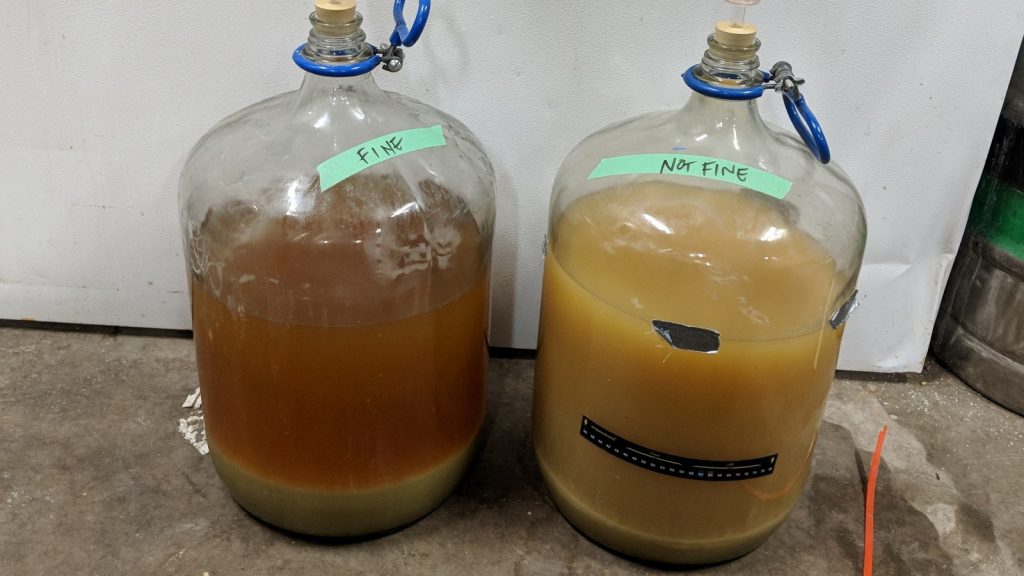
High kräusen was reached 32 hours later, at which point I added the biotransformation dry hop. When fermentation was finished, I added another dose of dry hops to each beer.
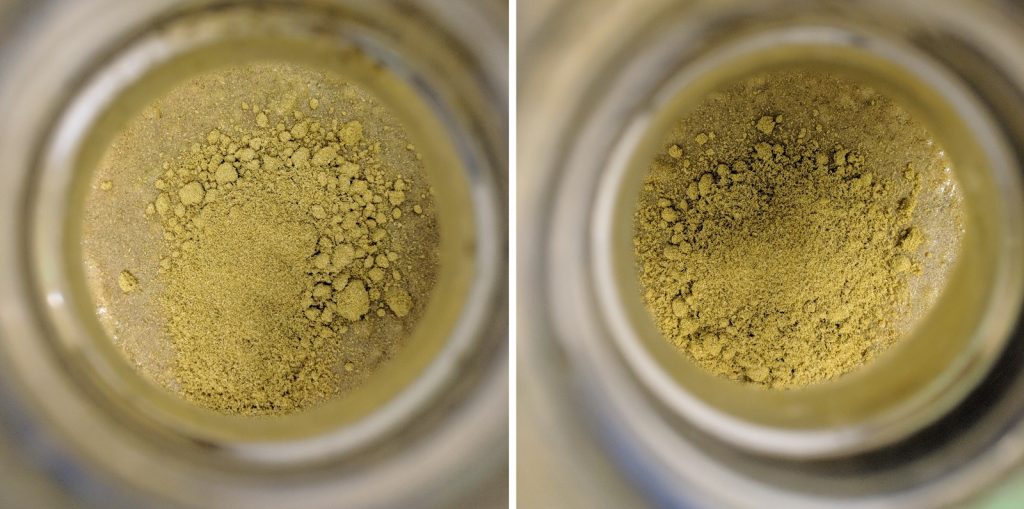
Hydrometer measurements showed both beers were sitting at the same FG.
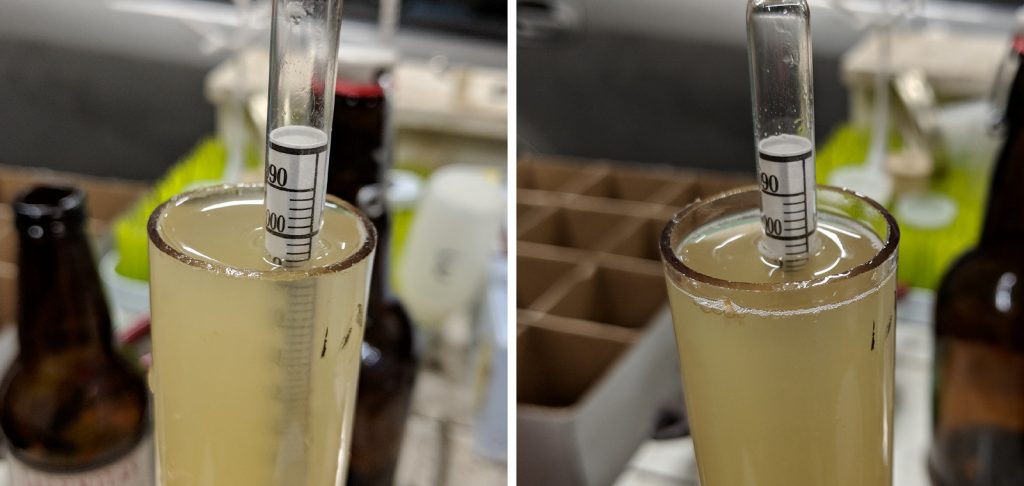
I gave them another 3 days before transferring the warm beer to kegs, at which point any differences in clarity caused by the Whirlfloc appeared to have diminished.
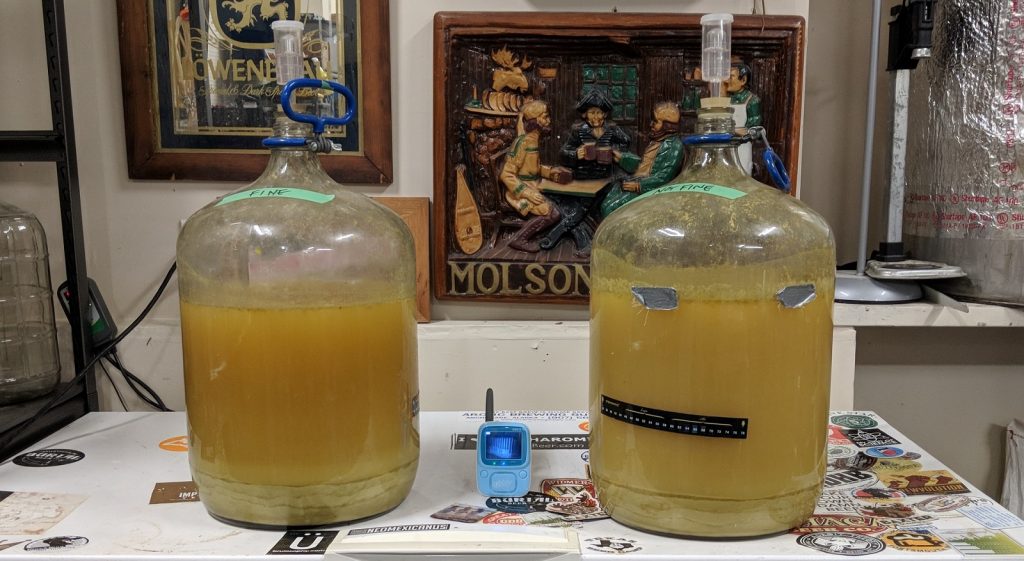
The kegs were placed in my keezer and allowed to chill overnight. Since gelatin didn’t seem to have much of an impact in a previous xBmt, my clarifier of choice for this xBmt was Super-Kleer, which is a two-part fining system. I added the first part, which contains Kieselsol, a negatively charged agent, then returned 24 hours later to add the second part, Chitosan, which is positively charged.
The beers were burst carbonated and left alone for just over 2 weeks before I began serving them to unsuspecting participants. There was some observable difference in clarity at this point, but it wasn’t as striking as I expected.
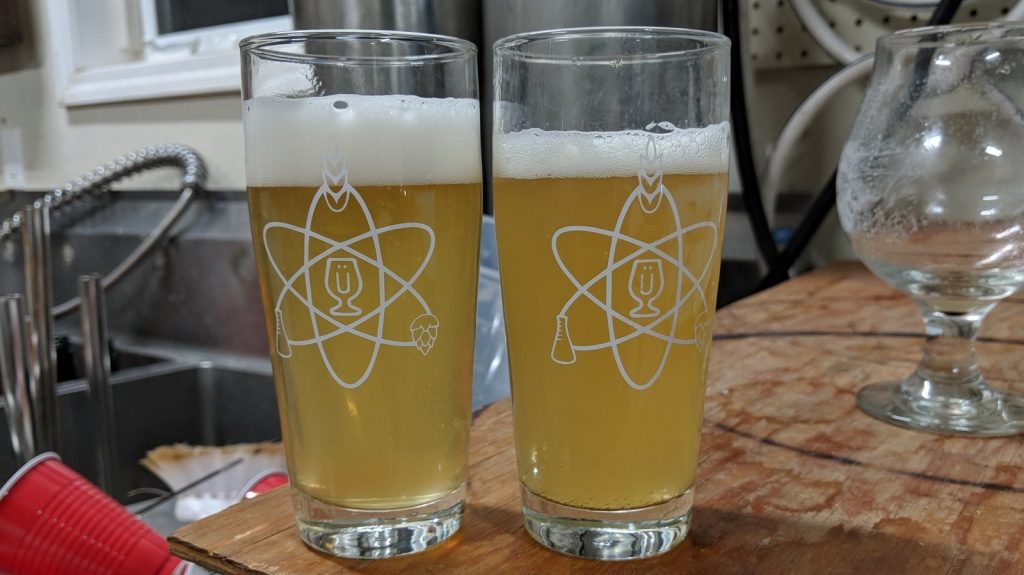
Curious of what might happen over time, I kept these beers around for awhile and paid attention to any changes in clarity. It took nearly 3 months for the fined beer to start looking noticeably clearer than the non-fined batch, though it wasn’t nearly as stark as I expected.
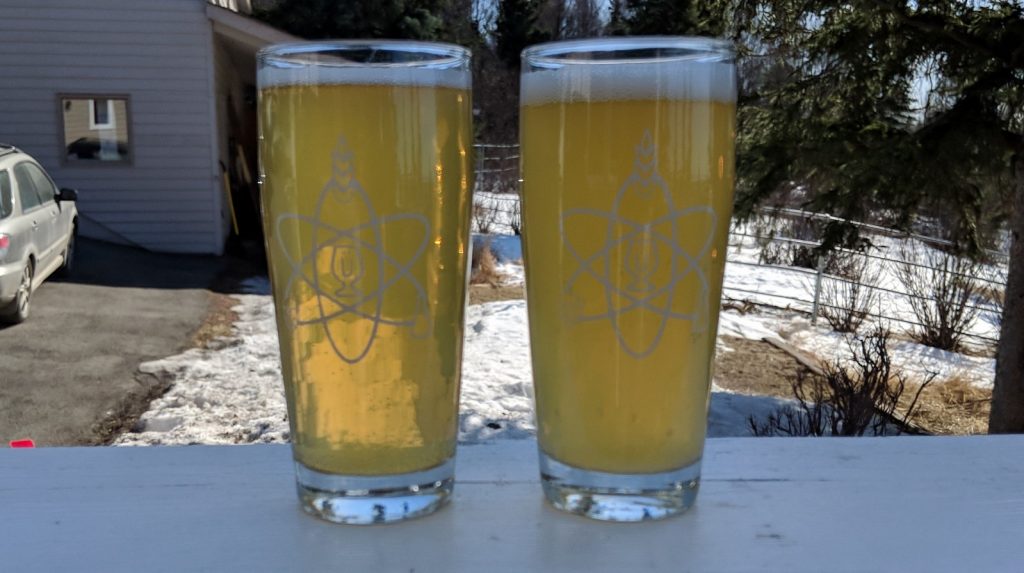
| RESULTS |
A total of 25 people of varying levels of experience participated in this xBmt. Each participant was served 2 samples of the NEIPA made with finings and 1 sample of the NEIPA made without finings in different colored opaque cups then asked to identify the unique sample. At this sample size, 13 tasters (p<0.05) would have had to identify the unique sample in order to reach statistical significance, though 12 (p=0.09) made the accurate selection, indicating participants in this xBmt were unable to reliably distinguish a NEIPA fined with Whirlfloc and Super-Kleer from one that was not fined at all.
Despite this xBmt failing to achieve significance at our selected threshold, we opted to share results of the preference evaluation to satiate curious minds. The 12 participants who made the accurate selection on the triangle test were instructed to complete a brief preference survey comparing only the beers that were different. A total of 3 tasters reported preferring the NEIPA that was fined, 7 said they liked the non-fined version more, and 2 tasters reported having no preference despite noticing a difference.
My Impressions: I attempted several semi-blind triangle tests at two different points, the first early on where I was right 5 out of 6 times, and the second after a the kegs had been around awhile where I was right 4 out of 7 times. In total, that’s 9 correct selections in 13 attempts, which indicates I was reliably able to tell the beers apart. I found it was harder to tell the difference after the beers had aged, but consistently perceived the non-fined beer as having a smoother mouthfeel, which I preferred, while the fined version seemed to have more of a bite in the finish. To my palate, the hop aroma and flavor was the same between the beers, the fining didn’t seem to have any impact on that.
| DISCUSSION |
We’ve gotten some crap for our ongoing effort to attempt to clarify a style of beer that’s known specifically for being hazy. Indeed, a characteristic aspect of NEIPA is its opaque and creamy appearance, and it’s not like these results will have some epiphinous impact on lovers of the style. So, what’s the point?
Contrary to what some might believe, our aim is to get a better grasp of a relatively new style of beer that has become ubiquitous around the world. As someone who began brewing NEIPA over 5 years ago when living in New England, back before it was its own style, I’ve personally got nothing at all against the haze. But that doesn’t stop me from wanting to better understand its cause as well as the effect it has on beer.
The fact tasters in this xBmt were unable to reliably tell apart a NEIPA fined with Whirlfloc and Super-Kleer from a non-fined version indicates such a step doesn’t produce much in the way of a noticeable difference. However, while it’s possible finings can be used without impacting the aroma and flavor of NEIPA, they didn’t have all that huge of an impact on clarity either, so perhaps it’s more work than its worth.
The fact I was able to reliably tell these beers apart when tasters couldn’t can seem quite confounding. First off, I had deep knowledge of everything about these beers and had sampled them many times before attempting my triangle tests, meaning I was very biased. Also, it wasn’t terribly easy, in fact I perceived the aroma and flavor as being identical, relying solely on a slight difference in mouthfeel to tell them apart.
In the end, the battle of hazy versus clear is ongoing and will likely persist for awhile, trivial as it may be. It’s true that some brewers go to odd lengths to make sure their NEIPA ends up as hazy as possible, which is a little weird seeing as the evidence continues to support the notion that the unique process for brewing this style is what’s responsible for its appearance. Either way, while I look forward to continuing to explore this topic, I have no plans to start fining the NEIPA I brew, but rather allow its natural cloudiness to shine.
If you have any thoughts about this xBmt, please do not hesitate to share in the comments section below!
Support Brülosophy In Style!
All designs are available in various colors and sizes on Amazon!
Follow Brülosophy on:
FACEBOOK | TWITTER | INSTAGRAM
If you enjoy this stuff and feel compelled to support Brulosophy.com, please check out the Support page for details on how you can very easily do so. Thanks!

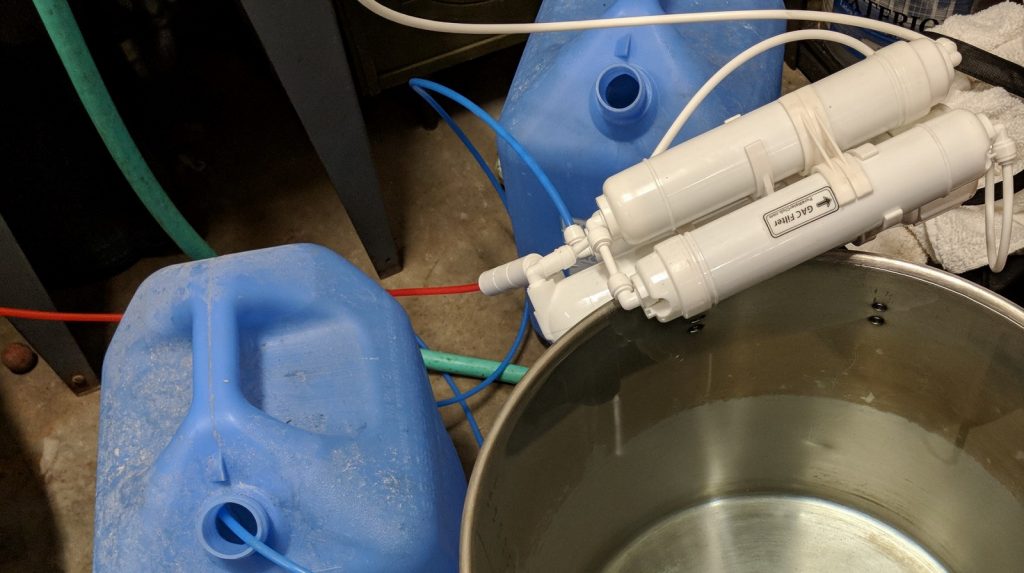
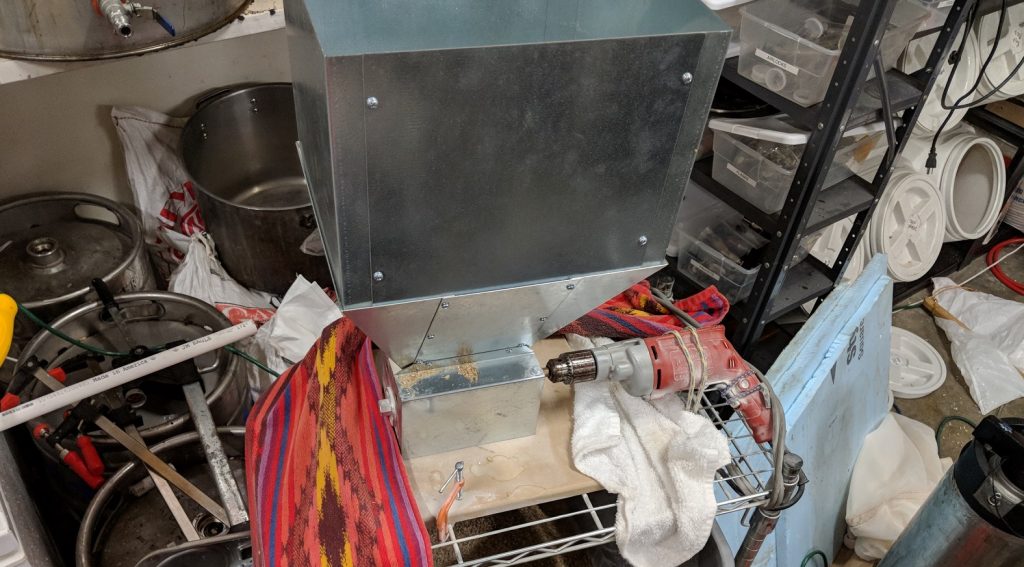
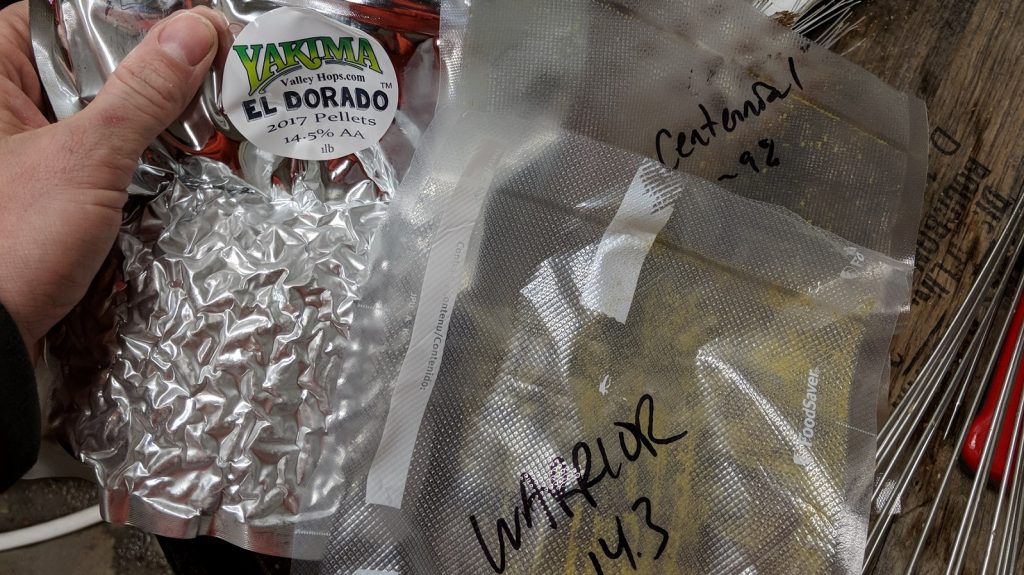
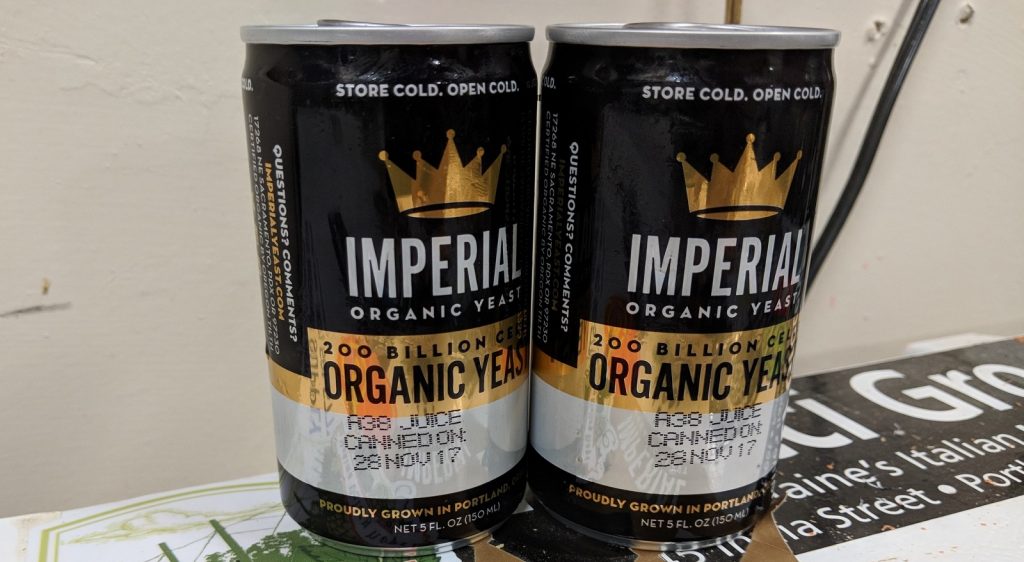
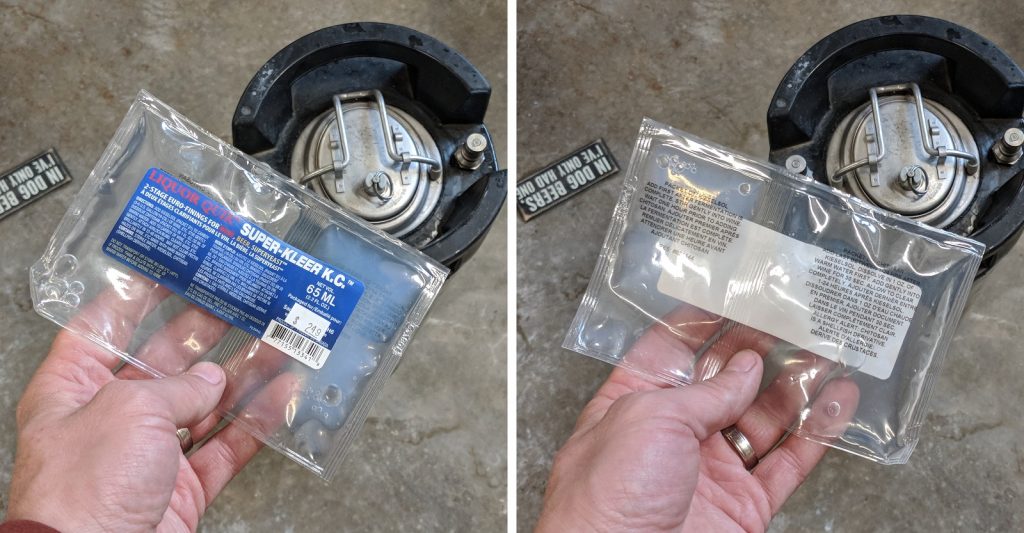










19 thoughts on “exBEERiment | Impact Using Various Fining Methods Has On Hazy IPA”
i’ve gotten to the point bow when i order an ipa and it is clear or getting clear, i feel a sinking feeling, knowing it wont be as hoppy.
Yeah I brewed a very similar NEIPA with the same yeast. It was great, hazy and hoppy for about 2 weeks, then it started to drop clear and it was just ok.
I can’t say I noticed a huge hop difference in these beers. Your comment reinforces that we drink with our eyes 🙂 Perhaps seeing the haziness in an IPA primes your mind for more hoppiness??
TOTALLY. I’ve had hazy ipa that wasn’t super hoppy and slightly hazy beer that was super hoppy, but I haven’t had many beers that were super clear and super hoppy. I start salivating when I see a super cloud-bomb ipa!
Maybe don’t cut off the total hops from the recipe on beersmith, as thats pretty much the only relevant part of your recipe, no one is gonna bother to calculate total amount of all of those hops.
8 oz in the kettle, 6 oz in the dry hop (some was cryo, so it’s “stronger”).
That literally took less than 30 secs FYI
Thanks for reading!
Have you looked at a lot vs a little biotransformation dry hop and it’s effect on cloudiness? You did an experiment in 2015 on a lot vs a little dry hop but with a west coast ipa. I’ve noticed, at least on the published experiments that’s your neipa are never really that cloudy and the only think left I can see is the amount of your bio transformation dry hop. Im only brewing my first one neipa now, and though it has less overall hops, 5/7 oz are in the bio transformation dry hop (trillium launch beer clone attempt). The results of the old experiment suggest participants would be able to discern between the two so maybe my suggestion doesn’t translate well to a double blind study.
How was the beer? I am looking for a NEIPA recipe to get me started.
https://www.homebrewtalk.com/forum/threads/northeast-style-ipa.568046/page-146#post-8203827
The entire thread is an amazingly helpful read, but that post has an excellent recipe to start with.
Beer was good, although not the best I’ve done. I used Franco Belges Pilsner malt, which seems to finish quite dry. I brewed four xBmt beers with the malt within a week (having never used it before) and they all finished 5 points lower than I was hoping. So the malt character isn’t really where I’d like it to be.
My NEIPA recipe tends to stick to 80% base malt, 20% oats, kettle hopping to 30ish IBU depending on gravity, then 6-14oz of dry hops, added two or three times.
I’d like to see this experiment repeated with Clarity Ferm. I, like so many others, suspect the haze is a bi product of polyphenols interacting with proteins, yeast biproducts, and hop oils. I happen to love the whole NEIPA craze. I have one going right now.
I’d second that for the following reason – I brewed my first ever NEIPA a month ago using a Scott Janish recipe. It was unbelievably cloudy in FV so I chose to add 2.5g gelatine to batch. However, pre ferment I also added 0.5ml of NBS Clarity as I’m coeliac and it reduces gluten content of beer. I sampled keg a couple weeks later and beer was crystal clear which wasn’t what I was shooting for at all. I’m going to rebrew in a few weeks and just cold crash to see if that changes things.
The NBS clarity should have only destroyed the gluten after all. It doesn’t affect a weizen for example but maybe in combo with gelatine produced a clear beer?
Gelatine is proline rich (~21%) so will be readily attacked by the proline endopeptidase in Clarity Ferm & its clones. But this could be another bit of evidence that the haze is principally (not exclusively) a function of protein-polyphenol interactions.
I’m not sure what polyphenols we’re talking about, but by the same token it might be interesting to treat a NEIPA with xylanase, which would certainly break down some.
I haven’t tried ClarityFerm in a NEIPA, but I’ll have to give it a a go!
the Kieselsol/Chitosan fining is very common in wine making. usually you are told to “de-gas” the wine completely before fining or the fining won’t work. not sure if the same is true when using in beer, but maybe that is why it didn’t clear.
also, i think isinglass is a more common fining for beer that commercial breweries use. maybe worth repeating exbmt with that.
keep up the great work. love the site.
Interesting that double fining this beer & extensive cold storage haven’t made it clear. To my mind, Occam’s razor suggests that the haze simply comes from heavy use of late and dry hops. The more hops, the more haze. I don’t see any need for special theories about oats, wheat, mineral interactions or biotransformation.
Regarding taste and mouthfeel, I suspect that hazy beers have softer mouthfeel than clear beers because the particulate matter somehow affect carbonation by providing nucleation sites. Perhaps dense haze reduces bubble size or degasses the beer quickly. A beer with less dissolved CO2 might also be somewhat less acidic/tart as it has less carbonic acid.
I got to the point that every time I see or hear HAZY IPA, I cringe, but I guess its just the sign of the times. This will pass just like MALT LIQUOR did years ago..